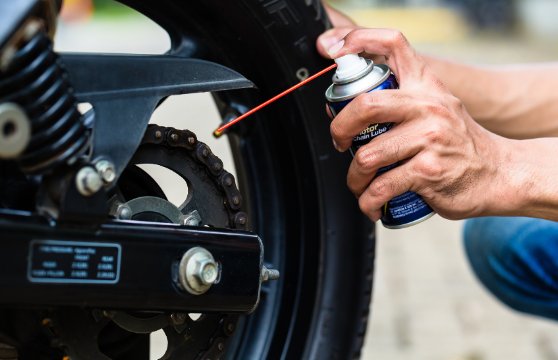Before revving up the engine and embarking on your next motorcycle adventure, it’s crucial to ensure your bike is in prime condition. A quick pre-ride inspection is not just a recommendation; it’s a necessity for safe and enjoyable riding. Experts suggest making this check a regular part of your pre-trip routine.
Safety Gear Reminder
In the excitement of preparing your motorcycle, it’s easy to overlook a critical aspect of safety – your personal protective gear. Before you even think about the bike, take a moment to check your safety essentials:
- Helmet: Inspect your helmet for any visible damage, cracks, or signs of wear. Ensure that it fits snugly and securely.
- Gloves: Check your riding gloves for any tears, loose seams, or wear and tear. They should provide a comfortable grip on the handlebars.
- Protective Clothing: Examine your riding jacket, pants, and any additional protective clothing (such as body armor) for any damage or compromised integrity.
Ensuring that your safety gear is in excellent condition is just as vital as inspecting your motorcycle. It provides an additional layer of protection and contributes significantly to your overall safety while on the road.
Now, let’s explore the components to inspect on your motorcycle.
Components to Inspect
Tires and Wheels
Firstly, assess the condition of your tires. Look for embedded objects, bulges, and signs of wear that could compromise safety. Checking tire pressure is particularly important in cold weather, as proper inflation is key to maintaining traction and handling. Don’t overlook your wheels – inspect them for bent or missing spokes and excessive grease, which might indicate a cracked seal. Additionally, ensure your brake pads and discs show no concerning wear and that the brakes function properly.
Controls
Your bike’s controls are its command center. Ensure that hand grips are securely fastened, handlebars are straight, and that they turn easily. Your throttle should move smoothly without producing any unintended revving sounds when the handlebars are turned. Examine your levers and pedals for proper adjustment, and check for any bends or cracks. It’s equally important to inspect cables and hoses for visible damage like cuts or kinks.
Lights and Electrics
The battery, being the heart of your bike’s electrical system, should be in top condition. Clean battery terminals and correct electrolyte levels are essential. Also, give your lights, including headlamps, brake lights, and turn signals, a quick test to ensure they’re operational. Inspect all wires, switches, and mirrors for any damage or cracks.
Oil and Other Fluids
Motorcycles rely on various fluids for smooth operation. Check levels of fuel, engine oil, coolant, hydraulic fluid, and transmission fluid. Be on the lookout for any signs of leaks in gaskets, seals, and hoses, as these can lead to more significant issues down the road.
Chassis
Examine the body of your bike for any cracks, especially in gussets and accessory mounts. Test bearings and bushings by pushing and pulling on swingarms and forks, ensuring everything functions correctly. Lastly, check the chain or belt for proper tension, lubrication, and engagement with the sprocket teeth.
Stands
A bike’s ability to stand securely is often overlooked. Inspect the condition of the center and side stands for any cracks or bends. Also, verify that the springs hold enough tension to keep the bike upright when parked.
The Motorcycle Safety Foundation (MSF) T-CLOCS Approach
To simplify your pre-ride inspection, the MSF suggests using the T-CLOCS method, reminding riders to check Tires and wheels, Controls, Lights and electrics, Oil and other fluids, Chassis, and Stands.
Addressing Detected Problems
If you spot a problem during your inspection, the response varies. Some issues, like topping off coolant, are easy fixes. However, more complex problems may require a visit to a repair shop for professional assessment and repair. Always gauge whether you have the necessary skills and resources before attempting DIY repairs.
Conducting Regular Checks
Regularly conducting these checks not only ensures your motorcycle’s condition but also helps you become more familiar with your bike. This familiarity means you’re more likely to spot potential problems before they turn into major issues. Though it might seem like a chore, a motorcycle pre-ride check is usually a quick process that goes a long way in ensuring your safety.
Troubleshooting Tips
In addition to conducting regular checks, it’s crucial for riders to know how to troubleshoot common issues that might be discovered during an inspection. Here are some practical tips:
- Low Brake Fluid: If you notice that your brake fluid level is low, it’s important to top it up to the recommended level immediately. However, low brake fluid can also indicate a leak or worn brake pads, which requires closer inspection or professional servicing.
- Tire Pressure Issues: If your tire pressure is consistently low, it could be a sign of a slow puncture. Regularly check for any embedded objects in the tire and consider having it repaired or replaced if necessary.
- Dimming Lights: Should your lights start to dim or flicker, this could indicate a weak battery or issues with your motorcycle’s charging system. A simple battery test can be done using a multimeter, but deeper electrical issues should be handled by a professional.
- Unresponsive Throttle: If the throttle feels sticky or unresponsive, it could be due to a need for lubrication or an adjustment. Check the cable for fraying or damage and apply lubricant if needed.
- Chain Tension Problems: A loose or overly tight chain can affect your ride’s quality and safety. Adjust the chain tension according to the manufacturer’s specifications and ensure it’s well-lubricated.
By being aware of these simple troubleshooting tips, riders can address minor issues before they escalate into major problems, ensuring a safer and more enjoyable ride.
Conclusion
In summary, safety should always come first when hitting the road on your motorcycle. Conducting a quick pre-ride inspection is a must for a safe and enjoyable ride. Remember to check your bike’s components and your safety gear. By following these steps and being prepared for common issues, you can ensure a safer and more enjoyable journey. Ride safe and savor the excitement of the open road!
Get the right coverage for your motorcycle with tutenagency
New tutenagency customers?
Quote motorcycle insurance online or call (334) 502-5111 to insure a motorcycle.
Disclaimer: This content is for informational purposes only and should not be considered legal or financial advice. Always consult with qualified professionals in legal and financial fields before making any decisions.

